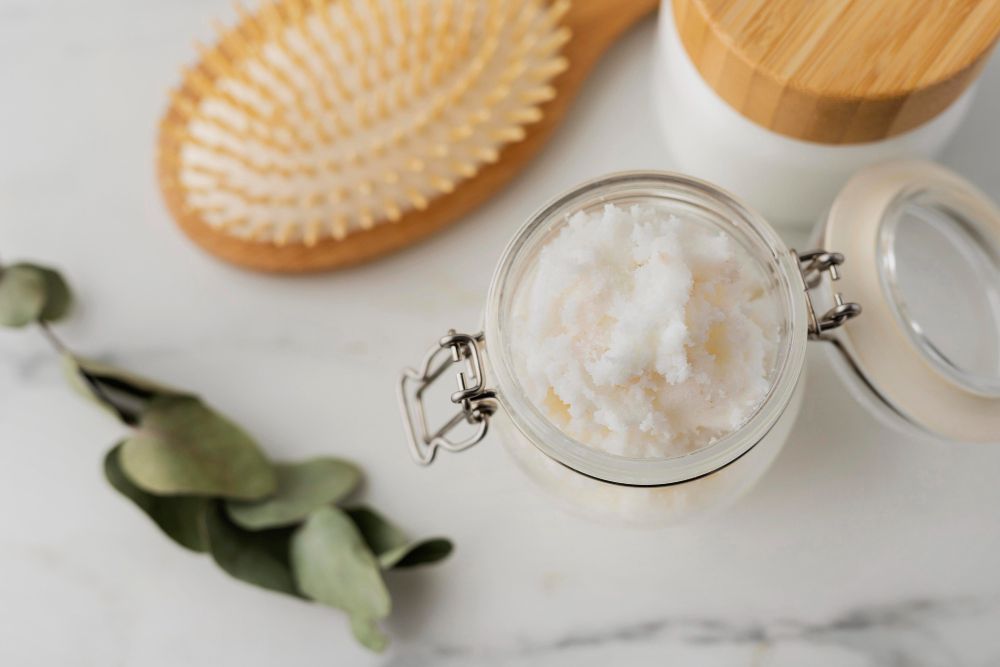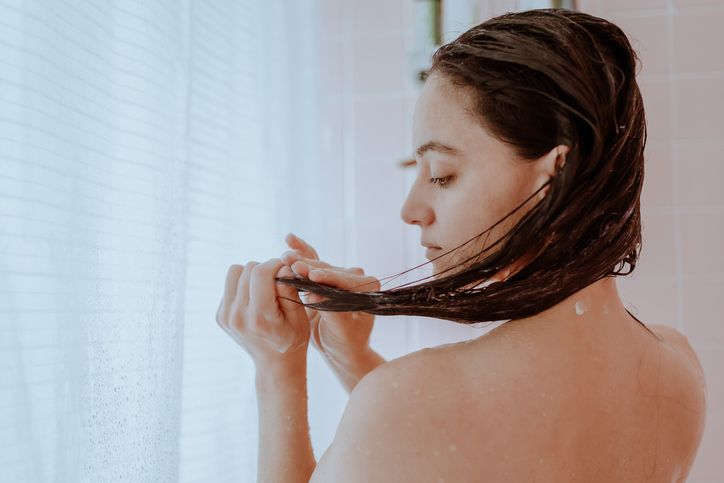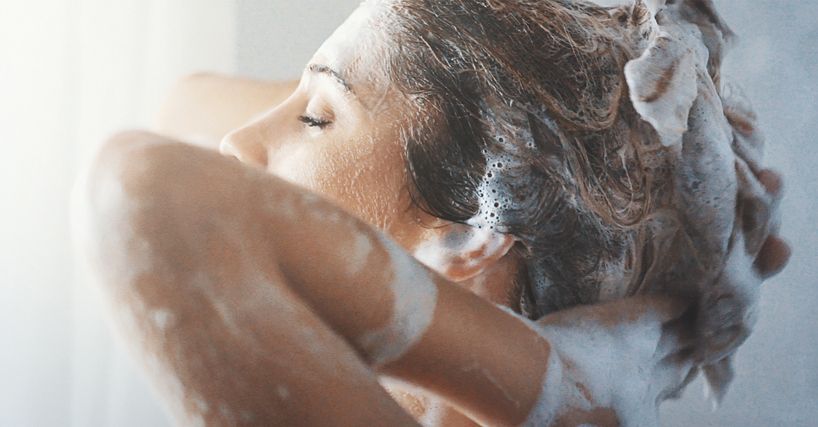
Author: Natalie Ng|Updated: 18 June 2025
Your scalp goes through a lot—oil, sweat, product buildup, and the occasional flakes. Over time, all of that can get in the way of healthy hair growth. That’s where a scalp scrub can help. It works a bit like a body scrub, clearing out dead skin cells and buildup so your scalp feels fresh again. The type of scrub you choose makes a difference, especially if you have an oily scalp or a sensitive scalp. Some formulas use physical exfoliators, while others rely on gentle acids like salicylic or lactic acid. A few also blend in natural oils like peppermint or coconut to help keep the scalp balanced and soothed. Using a scrub doesn’t take much effort—just a few minutes before shampooing can help your scalp feel cleaner. If your scalp’s been feeling dry, flaky, or weighed down, keep reading. We’ll walk through simple ways to use a scalp scrub that fit right into your regular hair care routine.

Choose the Right Type of Scalp Scrub for Your Hair

Using the right scalp scrub depends on your scalp condition and hair type. Scalp scrubs are a type of beauty product designed for scalp care. A good match helps clear away product buildup, excess oil, and dead skin cells without irritating your skin or stripping natural oils.
Physical vs. Chemical Exfoliants
Physical exfoliators use small particles to scrub away buildup on the surface of your scalp. These are often made with:
• Sugar crystals
• Salt
• Other natural grains
They’re most effective for oily scalp types or those who use a lot of styling products, as they help loosen visible flakes and product buildup.
Chemical exfoliants work more gently and are better suited for dry or sensitive scalp conditions. They don’t rely on friction but instead dissolve impurities using:
• Salicylic acid
• Glycolic acid
• Lactic acid
• Beta hydroxy acids (BHAs)
• Alpha hydroxy acids (AHAs)
These ingredients help reduce flakes and clear pores without the need for rubbing, which can benefit irritated or itchy scalps.
Choose Based on Hair Texture
Different hair textures respond better to different scrub textures. To avoid breakage or tangling, it helps to match the scrub’s physical form to your hair type.
• Fine or wavy hair: Choose scrubs with smooth, fine particles. These won’t catch on strands or cause friction.
• Thick or coarse hair: Slightly larger exfoliating particles can provide a deeper cleanse without damaging the scalp or hair.
Look for Nourishing Ingredients
A good scalp scrub should clean without leaving the skin dry or tight. Moisturising ingredients help calm the scalp and keep it balanced after exfoliation.
Look for scrubs that include:
• Sweet almond oil
• Coconut oil
• Seed oil
• Glycerin
• Vitamin E
These ingredients help keep your scalp nourished while preventing dryness, irritation, or tightness after rinsing. A well-formulated scalp scrub leaves your skin feeling fresh, not stripped.

Prepare Your Hair Before Applying a Scalp Scrub

Getting your hair ready before using a scalp scrub makes a big difference. When your hair is fully wet and neatly sectioned, it’s much easier to reach your scalp and apply the scrub evenly. Many scalp scrubs are designed for easy application, making it simple to target the scalp directly. This is especially helpful if you’re dealing with buildup, flakes, or an oily scalp.
Avoid using a scalp scrub if you have open sores or cuts on your scalp.
Wet Your Hair Thoroughly
Start by soaking your hair with warm water until it’s completely saturated. This helps soften dead skin cells and makes the scrub easier to spread across your scalp.
• Rinse your hair for at least a minute to make sure the roots are fully wet
• Warm water helps loosen buildup and open up pores
• A wet scalp helps the scrub glide on more smoothly and comfortably
Divide Your Hair Into Sections
Once your hair is wet, part it into four main sections—one from the front to the back, and another from ear to ear. Clip each section out of the way so you can work through your scalp bit by bit.
• Use your fingers to create smaller parts within each section, about an inch wide
• Keep the sections clean and open so you can see and reach your scalp easily
• This step helps you avoid missing areas, especially if you have thick or curly hair
Read More
Book Now to Experience
F8 Hair Regrowth Treatment
1 Minute Self-Registration
Date should not be before minimal date

Apply the Scalp Scrub the Right Way
Once your hair is wet and sectioned, it’s time to apply the scrub. Using the right technique helps you get the most out of the product without irritating your scalp. Whether you’re dealing with product buildup, flaky scalp, or excess oil, how you apply the scrub plays a big role in how well it works.
For a better experience, look for scrubs containing spearmint oil, which can provide a cooling and refreshing sensation during application.
After massaging the scrub into your scalp, leave it on for five minutes to ensure effective cleansing and chemical exfoliation before rinsing thoroughly.
Use Gentle Pressure With Your Fingertips
Scoop a small amount of your scalp scrub and apply it directly onto your scalp using your fingertips. Start with one section at a time and work your way through each part methodically.
• Use gentle, circular motions to exfoliate the skin
• Avoid using your fingernails, which can scratch or irritate the scalp
• Stick to your fingertips for better control and comfort
Take your time with this step. Rushing through can leave areas untreated, especially spots where buildup is heavier.
Adjust Pressure Based on Your Scalp’s Needs
Different parts of your scalp might need different levels of pressure. If you're new to scalp scrubs or have a sensitive scalp, start light and work your way up as your skin adjusts.
• Light pressure: Ideal for sensitive scalp or first-time users. Stick with circular motions for about 30 seconds per section
• Medium pressure: Works for general cleansing. Use a back-and-forth motion for around 20 seconds
• Firm pressure: Best for oily scalp or areas with stubborn buildup. Apply in slow spiral motions for up to 10 seconds
Don’t Skip Problem Areas
If you notice certain areas, like your crown or hairline tend to feel itchy, oily, or flaky, give them a little extra time. These spots often collect more styling product buildup or sebum. Just stay gentle to avoid irritation.
Spend around 3 to 5 minutes working through your whole scalp. The goal is to leave it clean and refreshed without over-scrubbing.

Time Your Scalp Scrub for Best Results
When you use a scalp scrub matters just as much as how you apply it. To avoid irritation and get the full benefits like reduced flakes, less buildup, and a healthier scalp—timing your scrub sessions the right way is key.
Use Before Shampooing
Always apply your scalp scrub before shampoo. Think of it as a pre shampoo treatment. This gives you a clean slate by removing product buildup, dead skin cells, and excess oil so your shampoo can work more effectively.
• Scrubbing before washing helps rinse away loosened debris
• It prepares your scalp to better absorb other hair products
• It also helps prevent flakes from sticking around
Stick to a Weekly or Biweekly Routine
How often you should use a scalp scrub depends on your scalp type. Overdoing it can dry out your scalp or cause irritation, especially if you're using a formula with strong active ingredients like salicylic acid or glycolic acid.
• Oily scalp: 1–2 times per week works best
• Dry or sensitive scalp: Once a week is enough
• Normal scalp: Once weekly is a safe place to start
Aim for a total scrub time of 5–7 minutes, including massage and rinse.
Watch How Your Scalp Reacts
After each use, check how your scalp feels. If it’s red, itchy, or tight afterward, give it more time to recover before your next session. If it feels clean, calm, and flake free, you’re on the right track.
Book Now to Experience
F8 Hair Regrowth Treatment
1 Minute Self-Registration
Date should not be before minimal date

Mix In Essential Oils for Added Scalp Benefits
Adding essential oils to your scalp scrub can take your routine further—especially if you’re targeting concerns like buildup, irritation, or slow hair growth. These oils offer extra support by calming the scalp, boosting circulation, or helping fight bacteria and flakes.
• Spearmint oil: Known for its cooling and anti-inflammatory properties, spearmint oil can help soothe scalp irritation, reduce flakiness, and promote a clean, refreshed feeling. Its minty scent also enhances the sensory experience of your scalp scrub.
Tea Tree Oil Helps Soothe and Clarify
Tea tree oil is known for its antimicrobial properties, which can help with dandruff, itchy scalp, and irritation caused by product buildup or excess oil.
• Add 2–3 drops to your scalp scrub or mix with a carrier oil like sweet almond or coconut oil
• Gently massage into the scalp for 3–5 minutes
• Let it sit for up to 30 minutes before rinsing and shampooing
Always do a patch test first, as tea tree oil can be strong for sensitive scalp types.
Lavender Oil Supports a Healthy, Calm Scalp
Lavender is a gentle, soothing oil that works well if your scalp feels tight, dry, or irritated. It also brings a mild fragrance that can make your routine feel more relaxing.
• Mix 5–7 drops into your scalp scrub
• Massage using small circular motions before washing
• Use before bedtime to add a calming effect to your routine
You can use this blend twice a week to help maintain a healthy scalp environment.
Rosemary Oil Encourages Growth
If your goal is stronger, fuller hair, rosemary oil is worth adding to your mix. It helps improve circulation to the scalp, which may support healthier hair growth over time.
• Combine 5 drops of rosemary oil with 2 tablespoons of carrier oil
• Apply the blend to your scalp and gently massage for a few minutes
• Let it sit for 20–30 minutes, then rinse and follow with shampoo
Use this oil up to twice weekly, especially if you’re focusing on growing thicker strands. Always patch test first to avoid irritation.

Rinse Your Scalp Properly After Scrubbing
Once you’ve finished applying your scalp scrub, how you rinse it out is just as important as how you applied it. Leaving behind scrub residue—especially if it contains sugar crystals, salt, or oils can cause buildup, irritation, or leave your hair feeling heavy. A proper rinse ensures your scalp feels clean, fresh, and balanced.
Use Lukewarm Water and Rinse Gently
Start with lukewarm water to help loosen the scrub from your scalp without drying it out. Avoid hot water, which can irritate the skin and strip away natural oils.
• Tilt your head slightly back so water flows from your forehead to your neck
• Let the water run through your hair while gently massaging your scalp with your fingertips
• Use a circular motion to help lift any leftover product and dead skin cells
Rinse Section by Section
To make sure nothing gets left behind, work through your hair one section at a time—especially if you’ve used a scrub with physical exfoliants like sugar or salt.
• Part your hair into four sections
• Massage each section with your fingers while rinsing to release all scrub particles
• Rinse until the water runs clear, which usually takes 3 to 4 minutes
Finish With a Cool Water Rinse
After all scrub particles are removed, switch to cool water for a final 30-second rinse. This helps seal the hair cuticle and can leave your hair feeling smoother and shinier.
Taking the time to rinse thoroughly keeps your scalp clean and helps prevent irritation from leftover scrub ingredients.
Book Now to Experience
F8 Hair Regrowth Treatment
1 Minute Self-Registration
Date should not be before minimal date

Match Scrub Frequency to Your Scalp Type
Using a scalp scrub too often, or not often enough can affect how your scalp feels and how your hair responds. The right frequency depends on your scalp’s natural oil levels, how much product you use, and whether you’re dealing with issues like a flaky scalp or buildup.
Scrub More Often if You Have an Oily Scalp
If your scalp gets greasy quickly or feels weighed down by styling products, you may need to exfoliate more frequently.
• Aim for 2–3 times per week
• Look for scrubs with physical exfoliators or chemical exfoliants like salicylic acid
• Pay extra attention to areas that tend to feel sticky or itchy by the end of the day
This helps control excess oil, clears blocked follicles, and keeps your scalp feeling fresh longer.
Go Gently if You Have a Dry or Sensitive Scalp
Scrubbing too often can make a dry or sensitive scalp feel worse. If your skin is prone to irritation, stick to a lighter routine.
• Use a scalp scrub once every 1 to 2 weeks
• Choose scrubs with soothing ingredients like glycerin, sweet almond oil, or lactic acid
• Avoid anything heavily fragranced or too gritty
This helps maintain a healthy scalp without stripping away natural sebum or causing dryness.
Find Balance for Normal or Flake-Prone Scalps
For scalp types that aren’t too dry or oily, once-a-week treatments usually work well.
• Weekly scrubbing helps manage dead skin cells and product buildup
• Choose formulas that balance cleansing with hydration, especially if you're using a lot of hair products
Adjust your routine as needed. If your scalp starts feeling dry or tight, space your sessions out more. If flakes or buildup return quickly, you can add one more session per week.

Use Targeted Ingredients for Specific Scalp Concerns
Not every scalp scrub is made the same. The key ingredients in your scrub can make a big difference depending on what your scalp needs. Whether that’s calming irritation, clearing buildup, or encouraging healthier hair growth. Choosing the right blend helps you get results that actually match your scalp condition.
Some scalp scrubs also include signature fragrances like white musk, offering a luxurious sensory experience as part of your routine.
For Oil Control and Dandruff
If you’re dealing with an oily scalp or flakes, go for ingredients that help purify and balance without over-drying.
• Tea tree oil and peppermint oil: These natural ingredients help clear bacteria and reduce itchiness
• Beta hydroxy acids (like salicylic acid): Help unclog pores and dissolve buildup
• Charcoal or clay: Absorb excess oil and draw out impurities
These ingredients are especially helpful if you use a lot of styling products or notice frequent scalp irritation.
For Soothing and Hydration
If your scalp is dry, itchy, or irritated, look for gentle, moisturizing ingredients that calm the skin and restore balance.
• Aloe vera: Naturally soothes and cools the scalp
• Glycerin and vitamin E: Help keep moisture locked in
• Sweet almond oil and jojoba oil: Nourish without feeling heavy or greasy
These work well for sensitive scalp types or anyone who’s scrubbing less frequently to avoid irritation.
For Removing Buildup and Dead Skin
If your goal is to deeply cleanse and refresh the scalp, exfoliating agents that break down buildup are essential.
• Sugar crystals or sea salt: Gently exfoliate dead skin cells from the surface
• Alpha hydroxy acids (like glycolic acid or lactic acid): Dissolve dull, flaky layers without scrubbing
• Briogeo scalp revival charcoal: A popular option for tackling both flakes and product buildup
Book Now to Experience
F8 Hair Regrowth Treatment
1 Minute Self-Registration
Date should not be before minimal date

Adjust Your Scalp Scrub Routine Over Time
Your scalp isn’t always the same throughout the year. Weather, product use, and even diet can affect how it feels. That’s why it helps to check in regularly and adjust your scrubbing routine as needed. Sticking to one method without paying attention to how your scalp reacts can lead to irritation, dryness, or missed results.
Watch for Signs That You Need to Change Things Up
After each scrubbing session, take a moment to notice how your scalp feels.
• If it’s still oily the next day, you might need to scrub more often
• If it feels tight, dry, or irritated, it’s probably time to cut back
• If you’re seeing flakes again, you may need to switch to a scrub with stronger exfoliants or clarifying ingredients
Match Frequency to What You Notice
Here’s a simple guide to help you decide what to do based on how your scalp is reacting:
• If your scalp feels clean and balanced: Stick to your current schedule
• If buildup returns quickly: Try increasing to twice a week
• If irritation starts showing up: Reduce to once every two weeks and choose a gentler formula
• If your scalp feels fine but your hair looks dull: Consider pairing your scrub with a clarifying shampoo or conditioner

Mistakes to Avoid When Using a Scalp Scrub
Even the best scalp scrub won’t give results if used incorrectly. To make the most of your hair care routine, it’s important to avoid habits that can cause irritation, imbalance, or reduced effectiveness. Unlike a scalp scrub, a body scrub is not suitable for the delicate skin of the scalp, as it is formulated for tougher skin and may cause irritation or even sores infused incorerectly.
Scrubbing Too Hard
Applying too much pressure can scratch the scalp and lead to redness or sensitivity, especially if you have a sensitive scalp or are using scrubs with salt or sugar crystals. Always gently massage with your fingertips, not your nails, and never treat the scrub like a harsh body exfoliant.
Using It Too Often
Over-exfoliating can strip the scalp of natural sebum, making it dry, itchy, or more prone to flakes. Even if you have an oily scalp, more isn't always better. Stick to your recommended frequency based on your hair and scalp condition.
Skipping a Patch Test
If your scrub includes essential oils, chemical exfoliants like salicylic acid or alpha hydroxy acids, or ingredients like peppermint oil, always test it on a small area of skin before full use. This step is especially important for those with dry scalp or skin sensitivity.
Ignoring Product Buildup
If you’re regularly using styling products, shampoo alone may not be enough to clear buildup. That’s why regular scalp exfoliation with scrubs formulated to dissolve product buildup and unclog follicles is essential. Ingredients like glycolic acid, charcoal, and briogeo scalp revival charcoal can help maintain a flake free, breathable scalp.

Support Your Scalp Care Routine With F8 Hair Regrowth Treatment
Using a scalp scrub helps create a cleaner, healthier foundation for hair growth—but it’s only one part of the picture. To strengthen hair follicles from within and improve scalp circulation, adding a professional treatment like the F8 Hair Regrowth Treatment can make a noticeable difference in how your hair looks and feels.
How F8 Works With Your Scalp Routine
After exfoliating with a scalp scrub to remove dead skin cells, excess sebum, and product buildup, your scalp is better prepared to absorb nourishing treatments. That’s where F8 comes in. This non-invasive procedure uses low-energy laser technology and a hair growth serum to stimulate scalp microcirculation and revive inactive hair follicles.
• The low-level laser energy activates the hair papilla and strengthens nearby capillaries
• This promotes better nutrient delivery to the scalp and hair roots
• The hair growth serum hydrates the scalp and helps maintain a balanced oil-water environment
By combining the exfoliating effects of a scalp scrub with the deeper stimulation of F8, you can create the ideal setting for healthier, fuller hair growth.
Benefits of F8 Hair Regrowth Treatment
• Non-surgical and safe: No downtime or skin damage—just gentle, targeted energy
• Improves blood flow: Laser energy encourages circulation, which helps nourish follicles
• Reduces sebum and buildup: The serum cleanses and calms the scalp, supporting a healthier environment
• Hydration and balance: Helps control excess oil while keeping the scalp moisturized
• Suitable for most users: Designed for both men and women with various scalp conditions
Whether you're struggling with oily scalp, thinning hair, or just want to improve scalp health after regular exfoliation, this treatment adds an extra layer of support to your hair care routine.
Book your F8 consultation today and give your scalp the care it needs to grow stronger, healthier hair.
New Beauty's F8 Hair Regrowth TreatmentBook Now to Experience
F8 Hair Regrowth Treatment
1 Minute Self-Registration
Date should not be before minimal date
FAQ
1. Can I use a scalp scrub if I have dandruff?
Yes, but it depends on the cause and severity of your dandruff. A scalp scrub can help remove dead skin cells and product buildup that contribute to flakes, especially if you’re dealing with an oily scalp or clogged follicles. Look for scrubs that contain soothing ingredients like tea tree oil, salicylic acid, or peppermint oil, which can help calm an itchy scalp and reduce visible flakes. Avoid harsh scrubs if your scalp is inflamed or sensitive, and consider checking with a board certified dermatologist if symptoms persist.
2. What's the difference between a scalp scrub and a clarifying shampoo?
A scalp scrub physically or chemically exfoliates the scalp to remove dead skin cells and buildup at the surface level. It often contains ingredients like sugar crystals, alpha hydroxy acids, or beta hydroxy acids. A clarifying shampoo, on the other hand, focuses on removing residue from hair products, excess oil, and styling product buildup from the hair shaft. Both can help with scalp health, but for clogged follicles and flaky scalp conditions, scrubs often give a more direct exfoliating effect.
3. Will a scalp scrub affect colored or chemically treated hair?
Some chemical exfoliants—like salicylic acid or glycolic acid—may slightly alter color-treated hair over time, especially if used too frequently. If you have colored or chemically processed hair, choose a scalp scrub that's labeled as color-safe and cruelty free, and avoid using it right after a fresh dye job. Look for scrubs that are formulated with hydrating ingredients like sweet almond oil, glycerin, or vitamin E to reduce the risk of dryness or irritation.
4. Can I use a scalp scrub if I have wavy or curly hair?
Absolutely. In fact, people with wavy hair or curls often experience more product buildup due to leave-ins, creams, or oils. A gentle scalp scrub used once a week can help maintain a clean, flake free scalp and reduce itchiness. Just be sure to apply it carefully by sectioning your hair and using gentle massage with your fingertips. Avoid tangling by working in small areas and rinsing thoroughly.
5. Is it better to use a scalp scrub before or after conditioner?
Always use a scalp scrub before applying conditioner. This allows the exfoliation step to remove impurities and dead skin, leaving the scalp clear and ready to absorb moisture from your conditioner. Using a scrub after conditioning could cause unnecessary friction or leave particles behind. If you’re using treatments like F8 Hair Regrowth, prepping with a scalp scrub beforehand may also improve the absorption of active ingredients from serums or low-energy laser therapy.
Recommended Articles
COPYRIGHT© NEW BEAUTY MANAGEMENT LIMITED 2025. ALL RIGHT RESERVED.




